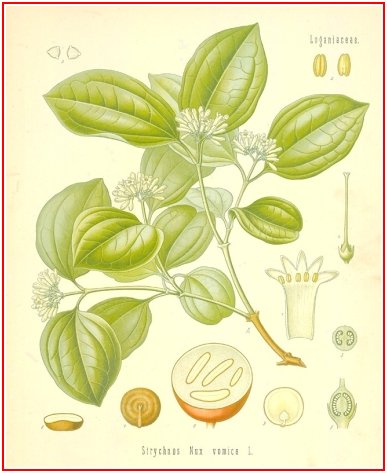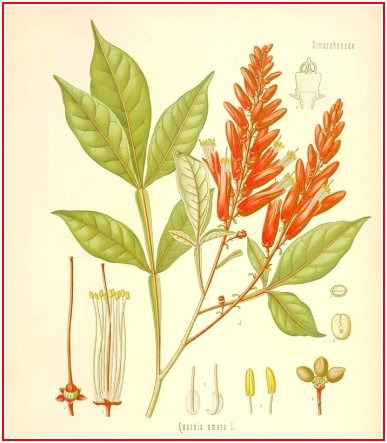
.............

Martindale's 24th Part 2
Compiled and Edited by Ivor Hughes
Nux Vomica (B.P., I.P.).
Nux Vom.;
Strychni Semen (I.P.); Noix Vomique; Brechnuss; Neuz vomica.
The dried ripe seeds of Strychnos nux vomica (Loganiaceae), containing not less than 1.2% of strychnine.
Foreign Pharmacopoeias:
In all pharmacopoeias examined. Many specify not less than 2.5% of total
alkaloids, about one half being strychnine.
Note. When Nux Vomica, Nucis Vomicae Pulvis, or Powdered Nux Vomica is prescribed, Prepared Nux Vomica must be dispensed.
Prepared Nux Vomica (B.P., Ind. P.). Nux Vom. Praep.; Nux Vomica Pulverata; Pulvis Strychni Seminis Standardisatus (I.P.).
Nux vomica in fine powder, adjusted with exhausted seed or lactose to contain 1.2% of strychnine. Protect from moisture in a cool place. Dose: 60 to 250 mg. (1 to 4 grains).
Toxic Effects and Antidotes. As for Strychnine.
Uses. Nux vomica, because of the strychnine which
it contains, acts as a bitter, reflexly increasing the gastric secretion and
appetite. Pills containing the dry extract in combination with laxatives
such as cascara sagrada are given for the treatment of constipation but
there is no evidence that nux vomica increases the action of laxatives.
Acid Mixture of Nux Vomica (B.P.C.). Mist. Nuc. Vom. Acid. (B.N.F.).
Tincture of nux vomica 10
m., dilute hydrochloric acid 10 m., chloroform water to 0.5 fl. oz.
Dose: 15 to 30 ml. (0.5 to 1 fl. oz.).
Alkaline Mixture of
Nux Vomica (B.P.C.). Mist. Nuc. Vom. Alk. (B.N.F.).
Tincture of nux vomica 10
m., sodium bicarbonate 10 gr., chloroform water to 0.5 fl. oz.
Dose: 15 to 30 ml. (0.5 to 1 fl, oz.).
Dry Extract of Nux Vomica (B.P., Ind. P.). Ext. Nuc. Vom. Sicc.; Extract
of Nux Vomica; Powdered Nux Vomica Extract; Extractum Strychni.
A defatted alcoholic
percolate, evaporated to dryness and adjusted with calcium phosphate to
contain 5% of strychnine; about 1/20 gr. in 1 gr. Store in small, wide
mouthed, well closed containers, in a cool place.
Dose: 15 to 60 mg. (0.25 to 1 grain).
U.S.N.F. specifies 7 to 7.75%; of strychnine. A
similar extract is included in many foreign pharmacopoeias which usually
specify 16% of total alkaloids.
Elix. Nuc. Vom. (B.N.F.). Nux Vomica Elixir.
Tincture of nux vomica 5 m.,
compound tincture of cardamom 20 m., syrup 60 m., chloroform water to 120 m. Dose; 8 ml. (120 minims).
Liquid Extract of Nux Vomica (B.P., Ind. P.). Ext. Nuc. Vom. Liq.; Nux
Vomica Fluidextract.
A defatted alcoholic
percolate, adjusted to contain 1.5% w/v of strychnine; about 1/24 gr. in 3
m.
Dose: 0.06 to 0.2 ml. (1 to 3 minims).
U.S.N.F. specifies 1.15% w/v of strychnine.
Tincture of Nux Vomica (B.P., Ind. P.). Tinct. Nuc. Vom.; Tinctura
Strychni (I.P.).
Liquid extract of nux vomica
8.34 ml. alcohol (45%) to 100 ml. It contains 0.125%, w/v of strychnine;
about 1/30 gr. in 30 m. I.P. is the same strength but is prepared direct
from nux vomica.
Dose: 0.6 to 2 ml. (10 to 30 minims).
U.S.N.F. specifies 0.115% w/v of strychnine, A
similar tincture is included in several foreign pharmacopoeias which usually
specify 0.25%;, of total alkaloids.
Picrorhiza (B.P.C. 1949, Ind. P.). Picrorh.; Kutki.
Dose: 0.6 to 4 g. (10 to 60
grains).
The dried rhizome of Picrorhiza kurroa (Scrophulariaceae).
Uses. A bitter used in India as a liquid extract
or tincture.
Compound Tincture of Picrorhiza (Ind. P.). Tinct. Picrorh. Co.
Prepared by macerating
picrorhiza 10 g., dried orange peel 3.75 g., and cardamom 1.25 g. with
alcohol (45%) 100 ml.
Dose: 2 to 4 ml. (30 to 60 minims).
Liquid Extract of Picrorhiza (Ind. P.). Ext. Picrorh. Liq.
Prepared by percolating
picrorhiza 100 g. with alcohol (60%) to 100 ml.
Dose: 1 to 4 ml. (15 to 60 minims).
 Quassia (B.P.). Quass.; Bitter Wood; Quassia Wood;
Quassiaholz; Leno de cuasia.
Quassia (B.P.). Quass.; Bitter Wood; Quassia Wood;
Quassiaholz; Leno de cuasia.
Dose: 120 to 500 mg. (2 to 8 grains).
The dried stem wood of Jamaica quassia, Aeschrion excelsa ( = Picroena excelsa (Simarubaceae), containing not less than 4% of water soluble extractive
Foreign Pharmacopoeias: In Belg., Dan., Egyp., Fr., Ger., Alex., Nor., Span. Swed., and Swiss. Also in U.S.N.F. All except Fr. allow also Surinam quassia Quassia amara (Simarubaceae)
Ind. P. specifics Picroena quassioides and other species of Picraena
Uses. Quassia is employed as a bitter stomachic to stimulate the appetite It is free from tannin and may be prescribed with iron salts. freshly prepared infusion of quassia (1 to 20 of cold water) has been used as an enema for the expulsion of threadworms, 5 fl. oz. being given on three successive mornings, together with 0. 5 oz. of magnesium sulphate by mouth. Infusion of quassia have been used as lotions for pediculosis.
Extracts of quassia or preparations containing quassin, one of the bitter principles of quassia, are used to denature alcohol and, with soft soap, all used as insecticides in horticulture.
Concentrated Infusion of Quassia (B.P.). Inf. Quass. Conc.
1 in 12.5; prepared by
maceration with cold water. It contains 21 to 24% v/v of alcohol.
Dose: 2 to 4 nil. (30 to 60 minims).
Enema Quassiae (B.P.C. 1949). Fresh infusion of quassia, undiluted.
Dose: 600 mil. (20 fl. oz.).
Ext. Quass. (B.P.C. 1949). Extract of Quassia.
Prepared by maceration still
percolation with cold water and evaporating the percolate to the consistence
of a soft extract. Protect from moisture.
Dose: 200 to 300 mg. (3 to 5 grains).
Fresh Infusion of Quassia (B.P.). Inf. Quass. Rec.
Quassia 1 g, and cold water
100 ml., infused in a covered vessel for 15 minutes, and strained.
Dose: 15 to 30 ml. (0.5 to 1 fl. oz.).
Infusion of Quassia (B.P.). Inf. Quass. Concentrated infusion of quassia
12.5 ml., water to 100 ml.
It should be used within 12 hours of its preparation. When infusion of
quassia is prescribed, fresh infusion of quassia may be dispensed.
Dose; 15 to 30 ml. (0.5 to 1 fl. oz.)
Mist. Quass. Acid. (N.W.F. 1947).
Infusion of quassia 120 m.,
dilute hydrochloric acid 10 m., chloroform water to 0.5 fl. oz.
Dose: 1 5 ml. (0.5 fl. oz.)
Mist. Quass. Alk. (N.W.F. 1947).
Infusion of quassia 120m., sodium bicarbonate 10 gr., chloroform water to
0.5 fl. oz.
Dose: 15 ml. (0.5 : fl. oz.).
Tinct. Quass. (B.P. 1948). Tincture of Quassia.
Prepared by macerating
quassia 10 g. with alcohol (45%) 100 mil.
Dose: 2 to 4 ml. (30 to 60 minims).
Taraxacum (B.P.C. 1949). Dandelion Root; Taraxacum Root; Pissenlit;
Lowenzahnwurzel.
The fresh or dried root of
Taraxacum officinale (Compositae). Store in a cool dry place.
Foreign
Pharmacopoeias: In Pol, and
Swiss (dried root). Also in Ind. P.C. U.S.N.F. specifies the dried rhizome
and root of the common dandelion, T. officinale or of the smooth or red
seeded dandelion
T. laevigatum. Uses. Taraxacum has been used as a bitter in
atonic dyspepsia, and as it mild laxative in chronic constipation. It is
usually administered as a liquid extract or as taraxacum juice.
Ext. Tarax. Liq. (B.P.C. 1949). Liquid Extract of Taraxacum.
1 in 1 ; prepared by
percolation with alcohol (30%). Dose: 2 to 8 ml. (30 to 120 minims).
Succ. Tarax. (B.P.C. 1949). juice of Taraxacum.
Expressed juice of taraxacum
3 vol. and alcohol (90%) 1 vol.; set aside for 7 days and filter.
Dose: 4 to 8 ml. (60 to 120 minims).
Taraxacum Fluidextract (U.S.N.F.). 1 in 1;
prepared by maceration and
percolation with alcohol, glycerin, and water.
Usual dose: 4 mil. (60 minims).
Other Bitters.
Aristolochia (B.P.C. 1934, Ind. P.). Indian Birthwort; Isarmul.
The dried stem and root of
Aristolochia indica (Aristolochiaceae). Used in India and the Far East,
usually as a tincture (1 in 5
Dose: 2 to 4 ml. Used for the same purposes as
serpentary.
Burberry Bark (B.P.C. 1923). Berberidis Cortex.
The dried stem-bark of the
common barberry. Berberis vulgaris (Berberidaceae).
Used as a bitter in the form of an infusion (1 to
20 of boiling water)
Dose: 15 to 30 ml. or tincture (1 in 10; dose: 2
to 4 ml)
Berberis (B.P.C. 1934). Indian Barberry.
The dried stem of Berberis
aristata (Berberidaceae). Ind. P.C. specifies the dried roots of B. aristata
and closely allied species. Used in India and the Far East as a bitter tonic
in intermittent fevers, usually as a tincture (1 in 10)
Dose: 2 to 4 ml.
Cimicifuga (B.P.C. 1934). Cimicif.; Black Cohosh; Black Snakeroot;
Bugbane; Actaeae Racemosae Radix.
Dose: 0.5 to 1 g. (8 to 15
grains).
The dried rhizome and roots of Cimicifuga racemosa (Ranunculaceae). It
contains about 15 to 20% of resin, which is known as cimicifugin It has been
used as a bitter and mild expectorant, usually in the form of a liquid
alcoholic extract (1 in 1)
Dose: 0.3 to 2 ml. or a tincture (1 in 10) dose: 2
to 4 ml.
Coscinium (B.P.C. 1923, Ind. P.C.). Ceylon Calumba; False Calumba; Tree
Turmeric.
The dried stem of Coscinium
fenestratum (Menispermaceae). It is extensively used in India and the Far
East as a bitter and as a substitute for calumba. It is normally
administered as an infusion (1 to 20 of boiling water)
Dose: 15 to 30 mil. or a Tincture (1 in 10) dose:
2 to 4 ml.
Cusparia (B.P.C. 1934). Cuspar.; Angostura Bark; Carony Bark; Cusparia
Bark.
The bark of Galipea
officinalis (Rutaceae). An aromatic bitter administered in the form of a
concentrated infusion (1 in 2.5)
Dose: 2 to 4 ml. It has been used in South America and the West
Indies for diarrhoea, dysentery, and dyspepsia. It is a constituent of
'Angostura bitters' which also contain cinchona and other bitter
substances.
Lupulin (B.P.C. 1934, Pol. P., Swiss P.).
Dose: 120 to 300 mg. (2 to 5
grains) in pills capsules or cachets.
The glandular trichomes separated from the strobiles of the hop plant,
Humulus lupulus (Cannabinaceae). An aromatic bitter, reputed to be mildly
sedative.
Lupulus (B.P.C. 1934. Cz. P. Fr. P.). Hops; Humulus; Glandulae Lupuli;
Strobili Lupuli; Houblon.
The dried strobiles of the hop plant, Humulus lupulus. An aromatic bitter
for improving the appetite and digestion. It is administered as a tincture
(1 in 5)
Dose: 2 to 4 ml. or a concentrated infusion, about 1 in 2.5. Dose: 4 to 8 ml
Lupulus preparations are incompatible with mineral acids and metallic salts.
Picrasma (Jap. P.).
Dose: 500 mg. The heartwood of Picrasma
ailanthoides ( Simarubaceae). It is used similarly to quassia.
Serpentary (B.P.C. 1949). Serpentaria; Serpentary Rhizome; Texan or
Virginian snakeroot.
Dose: 50 to 100 mg. (0.75 to 1.5 grains). The
dried rhizome and roots of Texan snakeroot, Aristolochia reticulata, and of
Virginian snakeroot, A, serpentaria (Aristolochiaceae). A bitter employed
with mineral acids and with other bitters in dyspepsia. It is an ingredient
of Compound Tincture of Cinchona of the B.P.C. 1949.
Simaruba (B.P.C. 1934). Simaruba bark: Orinoco Simaruba; Surinam Simaruba.
Dose: 1 to 2 g. (15 to 30
grains). The dried root-bark of Simaruba amara (= S. officinalis)
It has been used as a bitter and as an astringent in the treatment of
diarrhoea It is administered as an infusion or decoction (1 in 20).
Swertia (Jap. P.). Japanese Chirata.
Dose: 10 to 50 mg. (1/6 to
3/4 grain).
The dried flowering herb of Swertia japonica (Gentianaceae). A simple bitter
used similarly to chirata.
Tinospora (Ind. P.C.). Gulancha.
The dried stems, with the
bark intact, of Tinospora cordifolia (Menispermaceae).
Used in India as a
bitter, usually in the form of an infusion 1:20 of boiling water.
Dose 15 to 60 ml. or tincture 1:5 Dose 2 to 4 ml
![]()